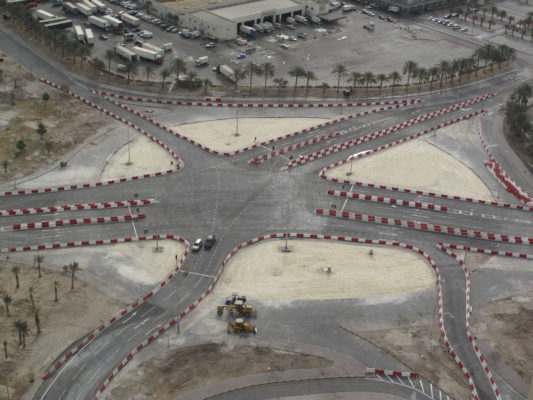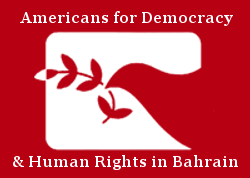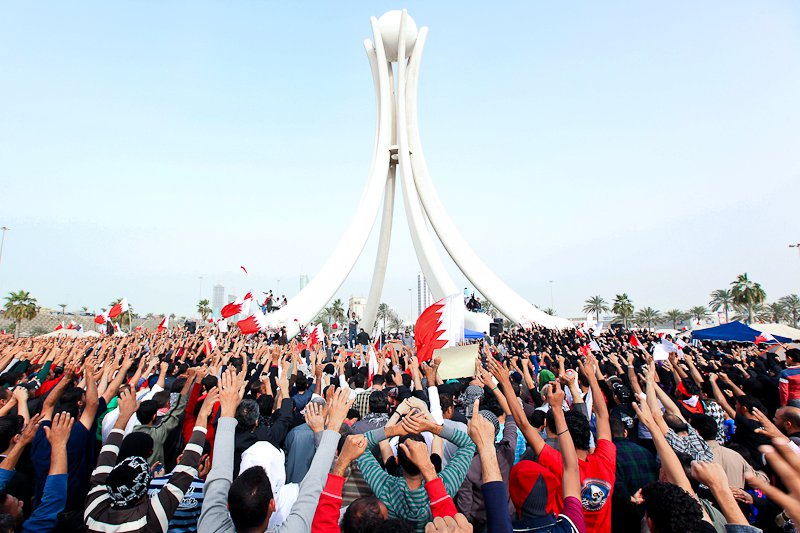
On 14 February 2011, thousands of Bahraini citizens joined together to peacefully call for democratic reforms and human rights protections. Two days later, on 16 February, the protesters occupied the Pearl Roundabout, a traffic circle in Manama that took its name from the 300-ft high pearl monument at its center. Demonstrators established an encampment and stayed overnight, even organizing speeches and political discussions. However, at 3:00 AM on 17 February, Bahraini security forces violently raided the gathering, killing and wounding protesters. By 19 February, demonstrators returned to the site and reoccupied the Roundabout until 16 March, when the security forces – bolstered by a contingent of Saudi and Emirati personnel-again attacked. This time authorities barricaded the area, preventing protesters from returning. On 18 March, the Bahraini government demolished the Pearl Roundabout, which had by then become a symbol for democracy in Bahrain and a focal point of the movement.
Six years later, on 14 June 2017, Bahraini authorities officially reopened the site of the Pearl Roundabout. Yet the importance of the symbolism was not lost on them. The center of the circle where the monument stood has been paved over as a road, and the site’s name changed to Al Farooq Junction. While the government claims that it has made “developments” to the area for economic reasons and to help the flow of traffic, this assertion neglects the historical significance of the location. Moreover, the authorities have made such claims to distract from an ongoing campaign to obscure and delegitimize the core symbols of democratic reform and the human rights movement in Bahrain.
International human rights experts have documented this worrying trend. On 11 July 2014, the UN Special Rapporteurs on cultural rights, the promotion and protection of the right to freedom of opinion and expression, and the rights to freedom of peaceful assembly and association issued a joint communication to the Bahraini government expressing great concern for the pearl monument’s destruction and calling for an end to ongoing suppressive measures. The communication specifically noted the Bahraini government’s apparent attempts to rewrite history, stating “That history teachings and memorial practices foster critical thought, analytic learning and debate, and open spaces to a variety of narratives regarding the past.”
The government did not stop at the demolition of the monument, but moved to erase all images of the roundabout and its connection to the pro-democracy movement. It pulled the 500 fils coin out of circulation because it was engraved with an image of the monument and removed postcards featuring its image from shops .Officials also removed pictures of the pearl monument from government websites. Citizens have responded by creating graffiti images of the monument, which are often quickly painted over, and by building makeshift replicas, which are often quickly destroyed.
The Bahraini government went even further when it renamed the plaza Al Farooq Junction, considered by many to be a provocative name intended to inflame sectarian divisions. Toby Matthiesen, Research Fellow in Islamic and Middle Eastern Studies at the University of Cambridge, explains the rationale: “To make clear that this was a victory of the Sunnis over the Shia, the junction that was built to replace the Pearl Roundabout was called Faruq Junction in honor of caliph Umar ibn al-Khattab…who is revered by Sunnis…but Shia generally do not accept the first three caliphs as righteous successors of Muhammad and dislike Umar.”
Sheikh Khalid Bin Ahmad Al Khalifa, Bahrain’s foreign minister, even alluded that the Pearl Roundabout had been demolished due to political motivations, describing the monument as “a bad memory.”
More broadly, the government’s erasure of the roundabout and its images represents a larger refusal to engage in substantive dialogue with the opposition. The government’s destruction of the site, which was a de facto forum for political debate and free expression, is indicative of its recently intensified campaign to undermine all forums for political discourse and civil society activity. In 2017 alone, the Bahraini government restored law enforcement powers to the National Security Agency (NSA), amended its constitution to allow military courts to try civilians, and dissolved the last major opposition group. In May, security forces raided a peaceful sit-in at the home of Bahrain’s leading Shia cleric, Sheikh Isa Qassim, after demonstrators camped out there to protest his arbitrary denaturalization. It was one of the kingdom’s deadliest raids in years, leaving five dead and hundreds injured.
The Bahraini government’s destruction of the Pearl Roundabout reflects its greater campaign to suppress political dissent and eliminate spaces that promote political debate. Its “redevelopment” of the site shows the government’s willingness not only to erase the symbols of democratic reform in Bahrain, but also to undermine the historical context necessary to foster reconciliation and dialogue. The Pearl Roundabout and the democratic movement it represents, must be remembered, especially as its legacy comes increasingly under attack.
Alex DiBell is an Advocacy Intern at ADHRB





